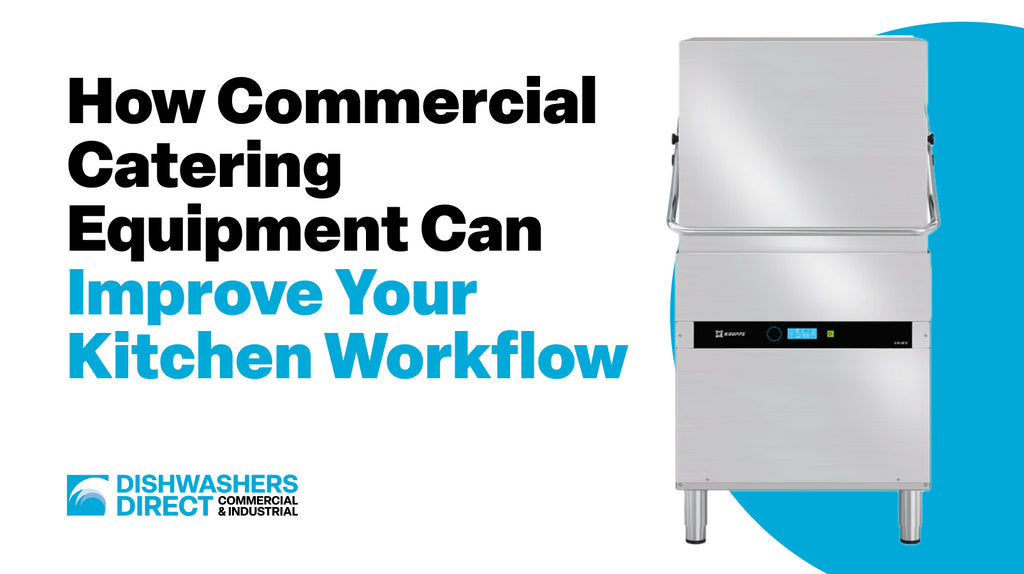How Commercial Catering Equipment can Improve your Kitchen Workflow
Posted by SAMUEL DEAKIN

Maximising efficiency is crucial for running a successful commercial kitchen. Learning how commercial kitchen equipment enhances workflow efficiency is essential to the success of any commercial kitchen. The right equipment can greatly improve the speed, accuracy, and safety of daily tasks.
Understanding the Basics of the Kitchen Workflow
Organising and running a kitchen can be challenging. A well-thought-out kitchen workflow plan will help you and your staff work efficiently and avoid crowded workspaces.
The basic workflow of a kitchen includes preparation, cooking, plating, and cleaning.
Visualise each of these steps and the equipment needed to complete them. Your kitchen should form a logical and efficient flow from each step to the next. For example, the area where servers pick up orders should be close to the plating station so that a finished dish only moves a short distance.
Everything must run smoothly from opening to closing for your kitchen workflow to be deemed a success. Prioritise the busiest parts of your kitchen such as food prep areas, storage access, and cooking appliances. These will have the biggest impact on productivity.
Quality Commercial Equipment for Enhancing Workflow
High quality equipment is more than just a luxury; it is an essential part of the commercial kitchen that ensures smooth and efficient operations.
Business owners are well aware that inefficient processes can significantly increase overheads and labour costs. This is where quality commercial kitchen equipment comes into play. Good-quality commercial kitchen equipment can act as a powerful tool to streamline operations, reduce unnecessary expenses, and enhance productivity.
High-grade products are built with functionality at their core. They often incorporate advanced technologies that increase speed and precision whilst decreasing energy consumption.
Regular maintenance checks are also essential to keep your machines running smoothly avoiding unexpected accidents during peak hours.
Pairing this with a strategic layout minimises disruption and maximises productivity.
Key Factors When Choosing Commercial Catering Equipment
The following factors will have an impact on the efficiency of your kitchen workflow:
Size and Capacity
Before choosing any commercial catering equipment, measure the area available in your kitchen.
Larger machines generally have a greater capacity and can do more work in a given time period. Capacity can refer to the amount of storage room or food items cooked per hour depending on the appliance.
Look for equipment with an ideal capacity for your needs. Too small and your profitability will suffer. Too large and you will spend more than you need.
Quality and Durability
Although it may be expensive, quality catering equipment can save you money in the long run.
Cheaper equipment is usually low-quality and fragile. Although it’s cheaper to purchase, frequent repairs and replacements end up costing more. Quality equipment that prioritises durability can often last as long as it’s well-maintained. It also protects your business from losing customers or productivity due to unexpected breakdowns.
Customisability
Customisable equipment can help save time, effort, and money by adjusting to your needs. It also allows for more flexibility in meeting customer demands.
Commercial Kitchen Design and Layout
When planning the ergonomic design of your kitchen, consider factors such as:
• The appropriate positioning of equipment, ensuring that frequently used tools and appliances are easily accessible.
• Creating sufficient space between each zone to avoid crowding and allow for ease of movement.
• Optimising lighting to create a safe and comfortable environment, with a focus on task lighting for enhanced visual clarity during cooking and preparation tasks.
Health and Safety Considerations
Some key health and safety considerations for optimising your kitchen efficiency include:
• Incorporating non-slip flooring materials and choosing appropriate footwear to reduce the risk of slips and falls.
• Installing ventilations systems that effectively remove heat, steam, and odours therefore maintaining a comfortable and contaminant free working environment.
• Allocating adequate space for waste disposal and recycling which will minimise the potential for cross-contamination and comply with hygiene regulations.
Final Tips for Implementing an Efficient Commercial Kitchen Workflow
• Plan Ahead: Consider which areas have the highest foot traffic, which tools are used the most, and where an order needs to go through each step of the workflow.
• Train Staff: Professional kitchens work best with coordinated teamwork. Once you’ve developed a workflow, it’s important to train all your staff on how it works.
• Organise Workstations: Items used the most frequently should be the most easily found. Think about stocking those items in multiple places if used in many parts of the kitchen.
• Regular Equipment Maintenance: Maintaining your catering equipment is the best way to prevent breakdowns and keep your workflow running efficiently.